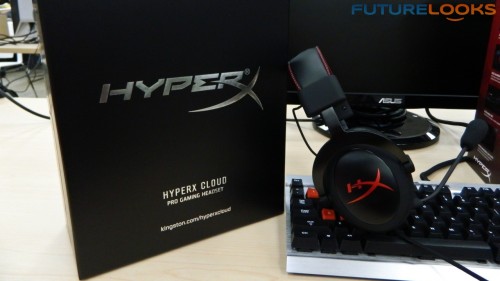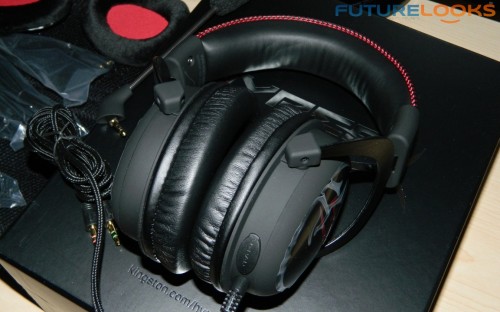Testing Notes
Four sources were used to truly understand the quality of audio in the Kingston HyperX Cloud Headset. Keep in mind that under-powered, or low quality audio sources tend to rob every audio output device of its potential, will feed that loss into an otherwise great headset. Often, adding a decent quality amplifier does wonders.
In this case, I used a number of common ways that gamers will power their headsets. This included both regular and amplified motherboard audio, to external (and internal) discrete audio cards.
- Integrated System: GIGABYE GA-Z87X-UD7-TH motherboard with Realtek ALC1150 audio processor. ($270 US/CA) The UD7-TH has a minor amplifier built in for front panel audio.
- Amplified Integrated System: GIGABYTE (Z87X) Sniper 5 with Creative (Titanium level) processor and Burr Brown amplifier. ($320 US/CA) The GIGABYTE Sniper 5 which has a superbly integrated Creative processor with additional high performance amplifier support. The audio quality is amazingly apparent with the amplifier.
- External Source: Creative Omni 5.1 ($60 US/CA) added to the GIGABYTE GA-Z87X-UD7-TH. The R3 is self powered through the USB and connected using analog ports.
- Audio card: Creative Sound Blaster ZxR ($299 US/CA) added to the GIGABYTE GA-Z87X-UD7 TH. The ZxR is a powerful step up beyond the R3 and Sniper 5. The clarity and quality of the audio is evident right at the start.
As mentioned, I had a great opportunity to get the feedback of other gamers at events like the recent Intel Infernalan, and I ended up taking a lot of notes. These are gamer made results ranging from ages 15 to 55, and we tested along a wide range of material, from Battlefield 4, Sound Cloud (Imagine Dragons – Radioactive Remix), and The Hobbit: An Unexpected Journey. So when I present my results, it’s actually “OUR” results.
Integrated Performance – GIGABYTE Z87X-UD7 TH
Despite the new Realtek ALC1150, and its somewhat limited integrated audio quality, 15 of the 20 gamers noticed that the audio was clearer than their own headset. Sure, part of that is good work that GIGABYTE has done with the Z87X-UD7 TH to make the stock audio experience better, but the output device, like the headset, has much to do with it too. The game and the movie seemed to present the strongest evidence of the HyperX influence, which makes sense. Music output usually samples down, cutting off frequencies found in the other two sources.
Integrated Amplified – GIGABYTE G1.Sniper 5
With the more powerful audio onboard the GIGABYTE G1.Sniper 5, we return with the same material, and more gamers. When paired with the Kingston HyperX Cloud Headset, every gamer described the headset as sounding powerful, very clear, and quite voluminous, with the exception of one. The bass was quite strong yet not overpowering. The midrange was very clear as well, and there was good extension of the higher frequencies. The HyperX Cloud carried many of the gamers away when viewing the movie though. Even I found myself getting immersed during down time.
Quite a few times, we’d have fellow gamers dragging their buddies in, for a closer listen. Word of mouth is extremely powerful.
External Source – Sound Blaster Omni 5.1
The Creative Labs Sound Blaster Omni 5.1 sports a great audio amplifier with the ability to drive even the most difficult headphones, and the ability to project surround sound fields. But we’ll focus on the stereo aspects, which is very high quality, driven by a good set of headphone amps. When the HyperX Cloud Headset was plugged in, about all the gamers said they expected there to be hissing with the Omni 5.1 given their experiences with external amplified sources in the past. However, most mentioned that no noise of any kind was noticeable, which is a nod in Creative Labs’ direction. Most of the gamers felt the headset produced lively frequencies and better quality volume than the integrated solutions, yet not loud enough to deafen. Given the specs of the Omni 5.1, this was right on the money.
Internal Audio Source – Sound Blaster ZxR
Almost identical to the integrated amplified results of the Omni 5.1, the ZxR was even more impressive. In fact, all but one gamer described the headset as exceptionally clear and robust through this source. Whatever tuning could be done within the ZxR’s software utility was completely evident within the HyperX Cloud headset. All three media tests did so well that many gamers looked over the configuration skeptically as if there were some hidden magic. Even more often, the gamer brought back a friend to have them sample the headset, to ensure that they weren’t hearing things.
Microphone Quality
Overall, through heated gameplay, to Skype calls, the audio on the other end of the microphone was never an issue. The mic element is noticeably larger than some of the other more low profile ones on the market, which means better overall pick up, and the ability to put proper noise cancelling elements into the shell. We found that even when it isn’t directly up to your mouth, it still manages to pull off a good performance, with little hiss, or bias to noticeable background noise.
Final Thoughts
Gaming headsets are seemingly a dime a dozen. Some are really expensive and have nothing to show for it, except flashy design. However, when you have gamers returning with their friends, to figure out if what they were hearing was truly what they were hearing, then you’re doing something right.
The Kingston HyperX team did a very good job with the design of the HyperX Cloud gaming headset. It has an extremely attractive design, it’s very compact overall, and most importantly, very comfortable. If it weren’t for the ear cups, you wouldn’t believe you were wearing a headset at all. The weight distributes nicely across your head thanks to the firm, yet well padded, head band, with sufficient width. The cups also don’t put any bothersome pressure on the ears. I often find myself forgetting that they are on my head, which is the mark of a great experience.
Additionally, choosing QPAD to design the headset, and having them use 53mm drivers was an extremely wise choice. QPAD makes great audio products, so going to the experts was almost a stroke of genius. Personally speaking, in my experience, the headset sounded excellent already, but having other gamers enlist their opinions, helped validate my own audio perception during tests. Games, music, and movies sound exceptional. Especially, when paired with a good audio source, which we had a good number to select from.
A couple very minor nitpicks came up. In regards to the cabling, the segments didn’t all match, and the metal ear frame support could use a bit finer machining on the edges, to ensure it doesn’t become the demise of the cables.
None the less, given included extras, attractive design, excellent audio quality, superb comfort, and a price tag of only $99 US/CA, the Kingston HyperX Cloud Gaming Headset is as close to perfect as it one can get, in mine, and the opinion of many others that I enlisted, and thank, for their honesty. This product is certainly worthy of this Editors’ Choice!
Pros
- Excellent audio quality
- Pairs very well with high quality audio sources
- Very comfortable
- Attractive, high quality design
- Extra cabling to suit all needs
- Optional inline volume controller and adapters
- QPAD collaboration and specifications
- Fantastic launch price $99
Cons
- Metal ear frame could use a little touch up
Overall Rating: 9.5/10

Help Us Improve Our Reviews By Leaving a Comment Below!



